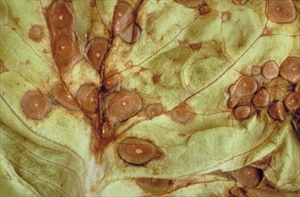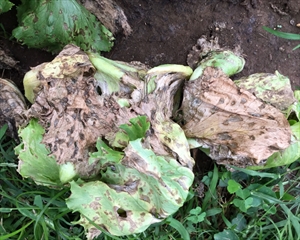Lettuce leaf spot
Pacific Pests, Pathogens and Weeds - Online edition
Pacific Pests, Pathogens & Weeds
Lettuce Cercospora leaf spot (210)
Cercospora lactucae-sativae; previously known as Cercospora longissima. It is closely related to Cercospora apii.
South and Southeast Asia, Africa, the Caribbean, Oceania. It is recorded from Cook Islands, Fiji, French Polynesia, New Caledonia, Niue, and Vanuatu.
Lettuce, chicory and endive, and weeds in the daisy and sunflower family.
A serious fungal disease. Leaf spots tan to brown, circular or oval, up to 1 cm diameter, with small (0.5-1 mm) whitish centres, sometimes with yellow halos, and joining together to cover large areas of the leaf, (Photos 1&2). The older leaves are infected first (Photo 3).
Spread is by spores produced on both sides of the leaf spots, splashed by rain, and blown in wind-driven rain. Survival is in crop debris, and also on weeds. High temperatures (25-35°C) and high humidity or rain favour outbreaks of the disease.
The leaf spots join together when conditions are favourable to the disease and large areas of the leaves are killed, and the plants are unmarketable (Photo 4). In the USA, there are reports of more than 5% losses even in crops that are routinely sprayed with protectant fungicides. It is a disease of the rainy season.
Look for the large black spots on the leaves, sometimes with haloes, and often merging. Compare with lettuce leaf spot caused by Septoria lactucae (see Fact Sheet no.150), which causes large irregular-shaped brown areas of rot between the veins - which become paper thin - containing tiny black fruiting bodies.
QUARANTINE
As this disease is not recorded in Fiji, Samoa, Solomon Island, and Tonga, biosecurity authorities should consider the potential pathways for entry.
CULTURAL CONTROL
Before planting:
- Keep nurseries free from weeds, especially those weeds in the daisy or sunflower family (Asteraceae).
- Avoid overcrowding seedlings. Make sure that there is sufficient air movement around them to dry leaves rapidly after watering or rain.
During growth:
- Space plants so that air can circulate around them; this helps to dry the leaves rapidly after irrigation or rain.
- Preferably, avoid overhead irrigation as this helps to spread the spores and provide water for germination and infection.
- Control weeds. Weeds can be a source of the fungus, and also increase the humidity around the crop so that leaves stay wet longer, and this promotes spore germination and infection.
After harvest:
- Collect plant remains, remove and burn or dig them deeply into the soil.
- Do not replant lettuce in the same land if the crop was diseased; leave a gap of 2-3 years.
- Avoid planting overlapping crops of lettuce if leaf spot outbreaks occur. It is common for old crops to infect younger ones.
CHEMICAL CONTROL
It should not be necessary to use fungicides to control this disease, cultural practices should be sufficient. However, if they are needed, use mancozeb.
____________________
When using a pesticide (even a biopesticide), always wear protective clothing and follow the instructions on the product label, such as dosage, timing of application, and pre-harvest interval. Recommendations will vary with the crop and system of cultivation. Expert advice on the most appropriate pesticide to use should always be sought from local agricultural authorities.
AUTHOR Grahame Jackson
Information from McKenzie E (2013) Cercospora lactucae-sativae: PaDIL - http://www.padil.gov.au. Photos 1&2 Kohler F, et al. (1997) Diseases of cultivated crops in Pacific Island countries. South Pacific Commission. Pirie Printers Pty Limited, Canberra, Australia.
Produced with support from the Australian Centre for International Agricultural Research under project PC/2010/090: Strengthening integrated crop management research in the Pacific Islands in support of sustainable intensification of high-value crop production, implemented by the University of Queensland and the Secretariat of the Pacific Community.







